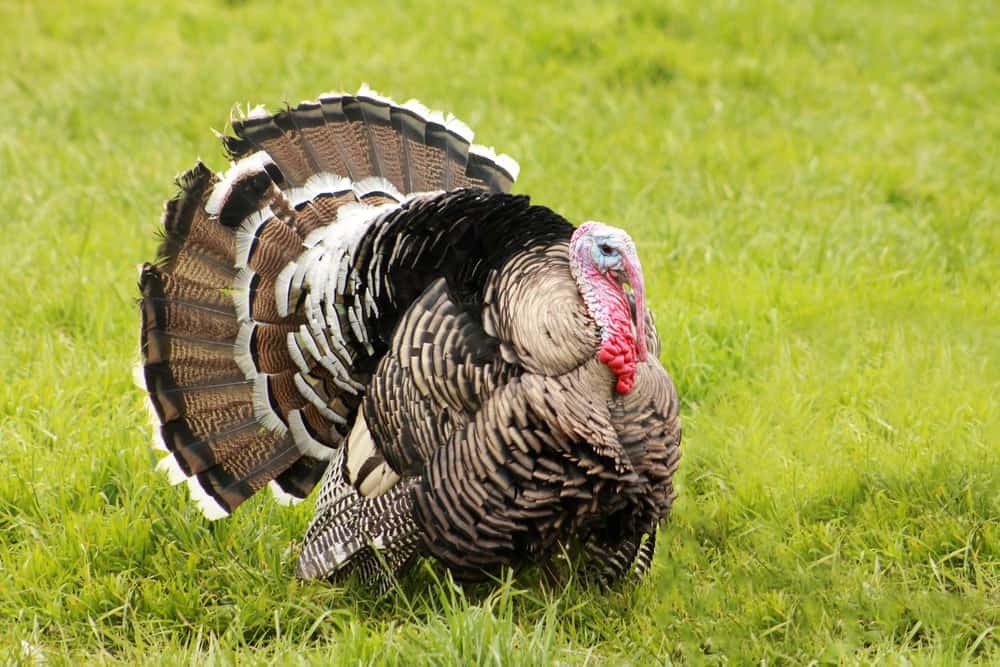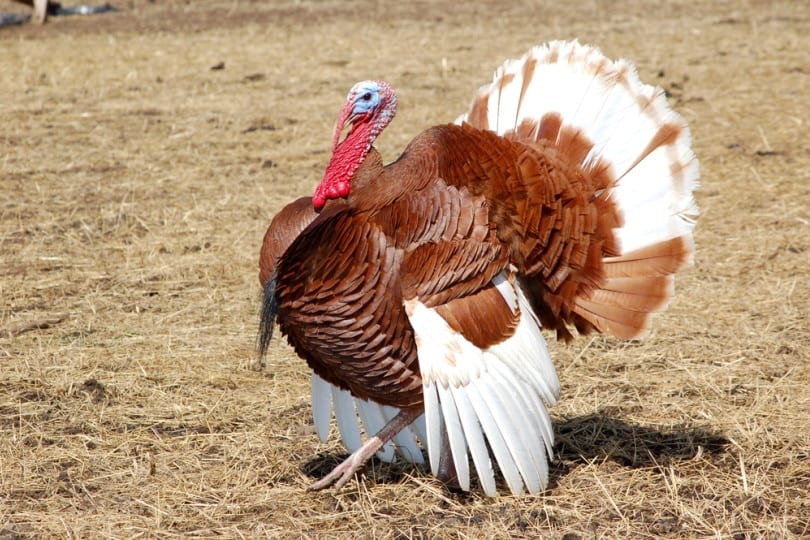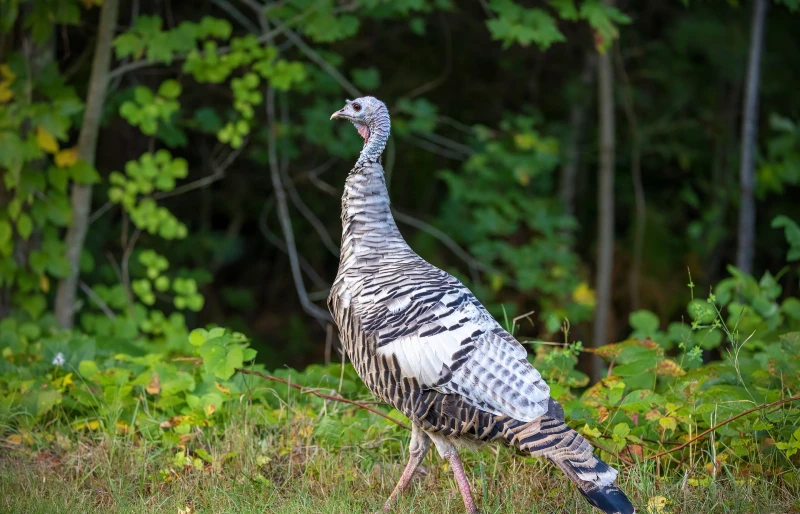If you know anything about turkeys, you are likely familiar with the gobbling sound that they are known for. Many of us even grew up saying “gobble, gobble, gobble” in school. But have you ever wondered if turkeys are capable of making other sounds? More specifically, do they purr?
You might be surprised to learn that turkeys are not only able to purr, but they also make quite a wide range of calls and sounds.
If you’re interested in learning more about the sounds that turkeys make beyond gobbling, we go over them all here and what each call means.

The 10 Different Sounds That Turkeys Make
Turkeys make a varied number of sounds that all mean something different. A few of these sounds are distinctive depending on whether it’s spring or fall. The following are the most common calls that turkeys make.
1. Purr
There are three distinctive purrs that turkeys make:
- Purrs:When a turkey purrs, it’s for much the same reason that other animals, notably cats, do. They purr when they feel safe and content. However, it’s also thought that the purring is a way of claiming the space that they are in. Like cats, the purr is a quiet and soft sound that is a single and long note that sounds something like “errrrrr.”
- Clucks and purrs: These typically happen when the turkeys are grouped in a flock while feeding. These noises reassure them that all is safe and that they can claim space again. It’s expressed as a combination of purrs and clucks, which can sound like “tuck, tuck, errrr — tuck, errrr.”
- Fighting purrs: These purrs tend to occur when both hens and toms are fighting for dominance or are agitated. They will puff up, and the purr can start to turn into more of a fighting rattle sound. These purrs are more frequent and are longer, and they tend to have a “putt” in the middle, like, “errrrrr, errrrrrr, errrrrrrr, errrrrrrr — putt — errrrrrr — putt, putt — errrrrrrrrr, errrrrrr.”

2. Yelp
The females, or hens, typically make one of the more common sounds (beyond the gobbling) in the wild, which is called the yelp. Male turkeys, or toms, also yelp, but it’s a little harsher and louder than the hen’s.
There are three different types of yelps:
- Plain yelps: This is the most common yelp, which can range from three to seven different notes but has been known to go up to nine or 10. The turkey makes three to four notes that are about a second apart, but the volume and pitch are the same for each note. These notes can sound like a “yup, yup, yup or a chirp, chirp, chirp.” Turkeys make the plain yelp when they see each other.
- Assembly yelps: These are similar to the plain ones except that they are longer and more dragged out and tend to increase in intensity. They sound more like “yuuup, yuuuuup, yuuuuuuup.” These yelps are essentially gathering an assembly for when birds are separated from the flock. This occurs mainly in the fall, when hens call to gather their poults (baby turkeys).
- Lost yelps: These are similar to the assembly yelp except in reverse. When younger birds are separated from the flock, they call out with more intense yelps. They typically call out 20 or more notes. They have an almost pleading sound that gets progressively louder towards the end of the sequence.
3. Putt
When a turkey makes a “putt” sound, it’s essentially an alarm when they hear or see something potentially dangerous to other birds in the flock.
It’s usually a single note and sometimes a series of notes. It’s not only used to warn other birds, but it also lets predators know that they have been spotted and they shouldn’t bother trying to attack.
Most often, a single “putt” is a quick warning, but several “putts” in a row can mean there’s a serious threat!

4. Cluck
This is another common sound that turkeys make that’s meant to grab another bird’s attention. It’s also used by a hen to get a tom’s attention, and sometimes turkeys cluck and purr while feeding. It’s usually a one- to three-note sound like, “cluck, cluck, cluck.”
5. Cutting
Cutting, also known as cutts, is a number of single-note sounds that are quite loud and fast. They are used when turkeys are excited and usually trying to get a response from another turkey.
A cutt is essentially a sign that a hen is ready to mate and is looking for companionship — it can be heard from quite a distance!
Cuttings usually come in rapid bursts of two to three notes, followed a few seconds later by another two or three notes.

6. Kee-Kee
This is one of the more common sounds that turkeys make in the fall. This call is made by juvenile birds and sometimes with a different variation by adult birds. They make about three uneven calls, like “kee, kee, kee,” when the young turkeys have strayed from the flock and are lost.
7. Tree Call
When turkeys roost in the trees overnight, they start to call in soft clucks and yelps early in the morning, which is essentially the birds talking to each other. The sound will begin to grow in volume as they get ready to fly down.

8. Fly-Down Cackle
This one is self-explanatory: Once the birds are ready to fly from their roost, they make noise. The cackle is a combination of sounds with a few yelps and clucks in the mix, which they do as they fly down.
They also cackle with other movements, such as flying up to roost or across a river. It’s usually three to 10 uneven notes, and it’s typically used only when they are moving and as a way to keep track of each other.
9. Spit and Drum
This is only done by toms. The male turkeys spit and drum in order to attract hens, but it’s harder for us humans to hear compared to other turkey sounds. Toms spit just before they drum, which sounds like “pfft, dooommmm”! They also sometimes add other sounds in the mix, like purrs, clucks, and yelps, but these are more often heard in the fall.

10. Gobble
Gobbling is primarily used by the toms in the spring to let hens know that they’re around but also to assert dominance. They gobble most at dusk and dawn.

What Other Birds Purr?
There are a few other species that purr or make a purring-type sound. It shouldn’t be too surprising to learn that doves and pigeons make purring sounds, as do certain starlings and parrots. It’s said that parrots purr to show affection, but while they can make purring sounds, they rarely do.
Several different animal species also purr or make purr-like sounds. These include bears, mongoose, hyenas, foxes, squirrels, rabbits, badgers, ring-tailed lemurs, guinea pigs, tapirs, and even gorillas.
Cats also purr — but technically, not all cats do. All domestic cats do purr and for many reasons. But big cats that roar can’t purr — these include lions, tigers, jaguars, and leopards — and all cats that purr can’t roar. Nature is a wonder!


Conclusion
Cats don’t have a monopoly on purring. Turkeys also purr and are capable of producing quite a wide range of other unique sounds.
Now you have a better understanding of turkey sounds, so the next time that you’re hiking, you might be able to identify the calls of a turkey in the distance.
Featured Image Credit: Adrian Eugen Ciobaniuc, Shutterstock
